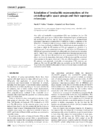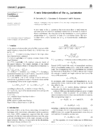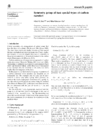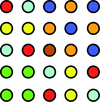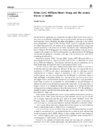issue contents
July 2013 issue

Cover illustration: Colorings of tilings can be used to model crystals and shed light on their structures. Colorings corresponding to index-12 torsion-free subgroups of the hyperbolic crystallographic group *32![[infinity]](/logos/entities/infin_rmgif.gif) are shown [Provido et al. (2013). Acta Cryst. A69, 445-451].
are shown [Provido et al. (2013). Acta Cryst. A69, 445-451].
research papers
Ab initio model reconstruction from fluctuation X-ray scattering data is described.
By using Lie group theory, the symmetry of displacively modulated structures may be described in the usual three-dimensional space. Moreover, when calculating the Fourier transform of such crystals, the structure factor may be clearly exhibited without requiring additional dimensions.
A tabulation of complete irreducible representations at all k points of three-dimensional crystallographic space groups and their extensions to (3 + d)-dimensional superspace groups is presented.
The tolerance of δ recycling phases to missing data-collection corrections and to deviations from kinematical behaviour of electron ADT intensities is analysed in detail. It has been found that Wilson-plot scaling is largely insensitive to sample thickness variations and missing absorption corrections.
A new statistical interpretation of the σA parameter is provided.
∊-Machine spectral reconstruction theory, a method for finding planar disorder in close-packed structures, is applied to four simulated diffraction patterns.
Open  access
access
 access
accessComputer control of beam tilt and image capture allows the collection of electron diffraction patterns over a large angular range, without any overlap in diffraction data and from a region limited only by the size of the electron beam. This results in a significant improvement in data volumes and ease of interpretation.
The symmetry group of two special types of carbon nanotori is studied using a group-theoretical result.
A technique to calculate the number of nonequivalent subsets of a lattice subject to periodic boundary conditions is presented.
A method is presented that will facilitate the determination of the subgroup structure of crystallographic Coxeter groups, including determining torsion-free subgroups.
essays
Sir W. H. Bragg was an outstanding teacher capable of exciting the minds of intelligent young people and addressing them to science in general and chemistry in particular. Both Primo Levi, a well known Italian writer, and Dorothy Hodgkin, Nobel laureate for her pioneering work in crystallography, decided that they would become chemists after reading, at the age of sixteen, Bragg's book Concerning the Nature of Things.
book reviews
Free 



 journal menu
journal menu











